Living in a Ski-aware Culture
by Janelle Jurek
April 16, 2002
"There is no cure for birth and death
save to enjoy the interval." - George Santayana
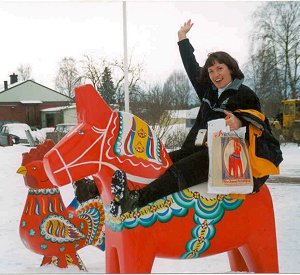 This article is for people who are curious about cross-country
skiing in Sweden. I'm a recreational skier from Minnesota
who has also cross-country skied in Canada, Finland, Norway,
and Japan. Although I have only lived in Sweden for one ski
season, I was flattered by Bruce's invitation to torment non-Scandinavian
residents with my anecdotes.
This article is for people who are curious about cross-country
skiing in Sweden. I'm a recreational skier from Minnesota
who has also cross-country skied in Canada, Finland, Norway,
and Japan. Although I have only lived in Sweden for one ski
season, I was flattered by Bruce's invitation to torment non-Scandinavian
residents with my anecdotes.
I arrived in Sweden during April 2001. While pushing my
bike box with my ski bag balanced on top through the Stockholm
airport, I was approached by Swedes (contradictory to the
shyness I expected from the travel and culture literature
I had read) offering me directions to the 'hiss' (elevator).
After some polite conversation about skiing, one Swede confessed
'I'm a tri-athlete.' What a dream! I was among people who
knew the difference between a downhill ski bag and a Nordic
ski bag.
Ski-wise people weren't limited to the airport. When I arrived
at my job and went through the usual getting-to-know-you questions,
I offered that I was a skier. The response to this statement
in Sweden is usually 'Alpine or cross-country?' Wow! They
don't assume a skier needs a towrope. This conversation was
repeated numerous times which amazed me since the majority
of my co-workers grew up in southern Sweden. It later became
apparent why they knew so much about cross-country even if
they weren't skiers themselves. (It's in their DNA!) It might
also help that Swedish schools close for 'Sports Love' week
each winter to allow families to enjoy winter sports together.
I can not think of a more conspicuous form of athletic training
than to roller ski in North America. After the effort to bring
my roller ski equipment to Sweden, I was somewhat disappointed
by the absolute 'uninterestingness' of this activity in my
small town of 18,000. Undaunted, I got off the bike trail
and onto the newly paved roadway. Cars made room, but didn't
slow down. No passengers in boats on the river stared. No
children pointed. No one asked if I was 'Nordic-tracking outside'
or 'what are those things?' My non-skiing coworkers even asked
me what brand roller skis I had. Had I tried Elpex? Sidenote:
Swedes have a lot of national pride in Swedish products. Hint:
To avoid a deluge of URLs in your email inbox, always answer
these inquiries, 'No, but what a great website.'
Soon the pressure was on at coffee break. Had I registered
for the Vasaloppet yet? It fills up quickly, May or June for
the 90 kilometer race. URLs to the race registration page
appeared in my email inbox. (Check
2003 registration availability!)
I went pole hiking in a popular hiking place. Rather than
meeting stares I met several like-minded people doing the
same. I joined the health club. There was extreme pressure
to have their trainer show me how to use everything and make
my initial training plan. I asked for something specific for
xc skiing. Done. Huh?
In about October, I started receiving junk mail from the
grocery store that was sponsoring a running race 'training
event' for the Vasaloppet including nutrition and training
suggestions for the 20 weeks leading up to the race. Advertising
flyers for television sets featured xc skiers on the screens!
A Swedish friend in another town mailed me bags of a new carbo
loading drink powder.
Sometime in the fall the 2002 calendars arrived in the supply
room at work. The Vasaloppet was pre-printed in them! I couldn't
believe it. I checked calendars at the bookstore. They had
it too! Karen, a fellow Sisu Skier, suggested we ski the HalvVasan
45 km classical race which is a Worldloppet Silver race. A
few minutes on the registration website and a trip to the
post office to pay the registration fee via 'post giro' and
we were entered. (If you register, don't expect a confirmation
response for months. There are lots of ways to get Worldloppet
credit for Vasaloppet races. You can ski the 90 km �ppet Sp�r
earlier in the week if you don't want to ski with 15,000 skiers
during the 'real' Vasaloppet. The TjejVasan, women only 30
km, and KortVasan, open 30 km, and SkejtVasan, 30 free technique,
all count as Worldloppet
Silver events. If you weren't able to register before the
race filled, you might be able to buy an entry off the message
boards on the Vasaloppet
website. We used the message boards to find a place to
stay in Mora with a family, which ended up being a really
wonderful experience for us despite the non-Swedish nature
of our household. The man of the house was Brasilian and the
woman of the house Danish! Unfortunately for foreigners, the
ads are usually in Swedish.)
Although my town has a very active orienteering organization,
I never found a xc ski training partner. I was on my own on
the lighted trail system and in the gym. Due to the frequent
rain and my frustration with wet feet from earlier rain when
it wasn't raining, I started calling it my 'indoor Vasaloppet.'
I was in poor shape from my vibrant social life at the pub
and I knew it.
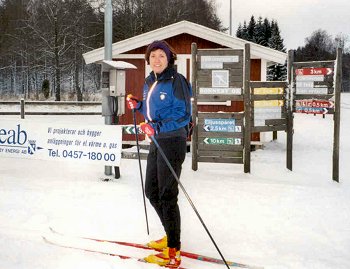 Working full time for a mobile phone software company did
not allow me as much time on snow as in previous seasons.
I live 5 km from the Baltic Sea in southern Sweden. Luckily,
we had a 'once in 10 years' snow season that permitted soft,
warm ski conditions most of January on a groomed 10 km hilly
course, and a 2.5 km lighted course. I got rained out twice.
Military aircraft enthusiasts might be interested in the fact
that the JAS 39 and the older Viggen do training exercises
from the airport in Ronneby. I saw them regularly while skiing
locally.
Working full time for a mobile phone software company did
not allow me as much time on snow as in previous seasons.
I live 5 km from the Baltic Sea in southern Sweden. Luckily,
we had a 'once in 10 years' snow season that permitted soft,
warm ski conditions most of January on a groomed 10 km hilly
course, and a 2.5 km lighted course. I got rained out twice.
Military aircraft enthusiasts might be interested in the fact
that the JAS 39 and the older Viggen do training exercises
from the airport in Ronneby. I saw them regularly while skiing
locally.
One Sunday afternoon while I was finishing my workout I
noticed a couple starting out with an unusual ski companion,
their cat. Sure enough, the cat was following them on their
ski. After a few questions, they offered that he gets to ride
in the backpack once he's tired. More typical is a whole family
out skiing: mom, dad, grandparent, and children. Really young
children in adorable one-piece snowsuits are not left to play
in the snow. They ski too!
In early February I was able to fly to Kiruna inside the
Arctic Circle in northern Sweden. My goal was to get some
ski training, attend the 397th Sami
winter market, and see the Ice
Hotel. Kiruna has some fabulous xc ski trails, lit at
night, with fun hills and bridges. From the trails, I could
hear the church bells from town. It was magical. 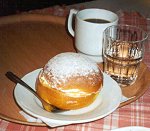 The people of the town still use sparks (kicksleds) to get
around and for this reason, sidewalks are not shoveled to
the surface below. A few centimeters of snow are left for
the sparks. I will also remember Kiruna for the food. Especially
the seasonal 'semlor', which is a round bread bun filled with
a cr�me and marzipan mixture, topped with powder sugar. These
are supposed to be for the pre-Easter season, but the shops
are making them earlier every year. It was cloudy during my
stay, so I didn't get to see northern lights inside the Arctic
Circle, though there is a research center in Kiruna studying
them. They even have a telephone hotline with information
and predictions on the likelihood of seeing aurora borealis.
The people of the town still use sparks (kicksleds) to get
around and for this reason, sidewalks are not shoveled to
the surface below. A few centimeters of snow are left for
the sparks. I will also remember Kiruna for the food. Especially
the seasonal 'semlor', which is a round bread bun filled with
a cr�me and marzipan mixture, topped with powder sugar. These
are supposed to be for the pre-Easter season, but the shops
are making them earlier every year. It was cloudy during my
stay, so I didn't get to see northern lights inside the Arctic
Circle, though there is a research center in Kiruna studying
them. They even have a telephone hotline with information
and predictions on the likelihood of seeing aurora borealis.
Later the same month, Emil and I drove to Mora, Sweden for
the TjejVasan (Women's Vasa), women's 30 km classical ski
race, and HalvVasan (Half Vasa), open 45 km classical ski
race. Both races were on the last half of the Mora Vasaloppet,
90 km classical, race course which winds through dense forest
downhill for the most part. For example, the HalvVasan starts
at approximately 425 meters in Evertsberg and ends at approximately
150 meters in Mora. The course is well marked with signs on
both sides of the trail at each kilometer that also includes
the name of and distance to the next aid station. The also
have the name of a Swedish telecommunications company on them�can
you guess? Ericsson.
There are striking similarities between Mora, Sweden and
Mora, Minnesota. Both have a river, lakes, and host a major
xc ski race every year. However, in Sweden they have mountains
and the locals speak Swedish. And the Swedish Vasaloppet has
6 major race days rather than one. It was exciting to finish
my races on the main street in town, right in front of the
Vasaloppet house, just like in Minnesota! I have to admit
I liked the blueberry soup better in the Swedish races. The
course has 4 set tracks most of the way and timing chips send
your progress to the web and via SMS (short messaging system)
to mobile telephones.
Emil was able to photograph Karen and I skiing because the
SMS was informing him when we were passing certain aid stations.
I saw men during the race off the edge of the course doing
what men usually do at the edge of the course, but some of
them were sending SMS during the race!
The snow was wonderful and the people were friendly. The
farm buildings near Mora are wonderful interlocking log style
with decorations on their roofline. It was paradise to hang
out in a place full of enthusiastic skiers. It was incredible
how well they managed the crowds. I guess 78 years of experience
pays off. The exposition tents featured wax recommendations
and waxing service on a daily basis. It was approximately
$14 USD to have your skis prepared. I did my own following
the recommendations from Toko called 'Vallatips' conveniently
printed in both Swedish and German.
Here are the Vallatips for the glide zone for the TjejVasan
2002.
1. V�rm in TOKO Molybden L�g fluor.
2. L�t skidorna kallna, sickla och borsta.
3. V�rm in TOKO R�d L�gfluor.
4. L�t skidorna kallna minst 30 min, sickla och borsta.
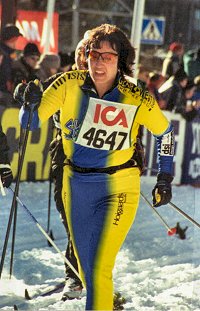 The morning of the HalvVasan, Karen and I caught a bus to
the start. We didn't realize that we needed to stake out our
territory for a starting position. After testing our wax,
we did put our skis down in the tracks and this proved to
be a smart thing, since we were able to start somewhere in
the middle of the pack. Actual start time is activated when
your timing chip goes over the timing mat at the start time
for the HalvVasan (not so for the TjejVasan which has waves).
The tracks were crowded and you needed to look ahead to pick
a route the first 10 km. There were slowdowns before downhill
sections, but I never experienced a complete stop. The tracks
were in good condition, and rarely worn completely away. Food
and wax stations were sometimes congested, but never obstacles
to progress. Despite skiing the American Birkebeiner-Kortelopet
22K and switching time zones 2 days before the race, Karen
past me at about 19 km finishing 7 minutes ahead of me. Postrace
we enjoyed incredibly proficient drop bag service, valet ski
service, and hot, but crowded shower facilities near the finish
line. Later that day, we picked up our color diplomas. Diploma
frames are an extra $12 USD, approximately.
The morning of the HalvVasan, Karen and I caught a bus to
the start. We didn't realize that we needed to stake out our
territory for a starting position. After testing our wax,
we did put our skis down in the tracks and this proved to
be a smart thing, since we were able to start somewhere in
the middle of the pack. Actual start time is activated when
your timing chip goes over the timing mat at the start time
for the HalvVasan (not so for the TjejVasan which has waves).
The tracks were crowded and you needed to look ahead to pick
a route the first 10 km. There were slowdowns before downhill
sections, but I never experienced a complete stop. The tracks
were in good condition, and rarely worn completely away. Food
and wax stations were sometimes congested, but never obstacles
to progress. Despite skiing the American Birkebeiner-Kortelopet
22K and switching time zones 2 days before the race, Karen
past me at about 19 km finishing 7 minutes ahead of me. Postrace
we enjoyed incredibly proficient drop bag service, valet ski
service, and hot, but crowded shower facilities near the finish
line. Later that day, we picked up our color diplomas. Diploma
frames are an extra $12 USD, approximately.
One of the best discoveries about Mora was the local ski
club's trail facility. The trails were perfectly groomed,
well marked, lighted until 9:30 PM, and best of all included
heated toilets, showers, and a fabulous waxing room with built
in wax benches and 1-hour timers for lights and power outlets.
I kept thinking about the vandalism and security problems
that inhibit a similar facility in Minneapolis. I was impressed
by the number of people out skiing during such a busy week.
A coach was working with two high school aged girls on classical
skiing without poles. I recognized the drill as one also used
by our Minnesota coaches. An impressive number of people came
to ski by bicycle. I admired the ease with which they set
their skis and poles over the handlebars and along the frame
before pedalling away.
If you ever go to Mora, I highly recommend the Vasaloppet
Museum. They have a video about the history of the race, which
includes some film footage of the first Vasaloppet! There
is also other memorabilia such as the King of Sweden's skis
and bib numbers. He has completed the Vasaloppet 3 times!
They have a nice collection of historical wax, skis, ski bindings,
and roller skis. I didn't know roller skis have been around
since the 1940s!
The second best discovery in Mora was the Kaffestugan (The
Coffeehouse). They made special Vasaloppet desserts that were
of course, blueberry, with a formed chocolate on top in the
shape of a Vasaloppet medal. In their front window, they created
a Vasaloppet aid station out of marzipan, complete with tiny
cups of blueberry soup to give the skiers.
Other things worth doing while in Mora, are to visit the
Anders Zorn Museum (famous Swedish painter and sculpture who
is best known for painting portraits and has painted 3 USA
Presidents,) and the Dala Horse factory. Factory tours in
Sweden are amazing to me. We were free to walk among the workers,
except those sanding and painting, where there were viewing
windows. No trip to Dalarna, the region of Sweden where Mora
is located, is complete without a stop at the 13 meter, 67
ton Dala horse in Avesta. He's big!
Back in my flat on Vasaloppet Sunday, we were able to watch
the race televised live in its entirety! I couldn't believe
it. They even had a commentator skiing the race for the first
time giving live reports from the racecourse.
It was a great season for ski visualization. I was able
to watch the top skiers at some event, either Olympics or
World Cup every week on television. I was amazed at how quickly
I was able to recognize skiers by their technique and make
generalizations about national ski styles. It's a shame the
doping scandals tainted this ski season, too. Nonetheless,
it was TV worth watching. Prior to the Olympics, xc skiers
were often front page news. I don't mean the sports section.
I mean THE front page. One day, the Norwegian Olympic team's
glide wax-testing tent was on the front page with large color
photos. The Olympic TV coverage was superb, too. Entire events
were broadcast, annoyingly switching channels in the middle
of an event, but not switching which event was being covered.
I enjoyed watching the skiers blink and breathe while shooting
during the biathlon! Despite Swedish Magdalena Forsberg's
two bronze medals at the Olympics, the Swedes renamed the
Olympic xc ski venue in Salt Lake City 'Sorrow Hollow.'
I know I've only scratched the surface of this delightful
place to be a skier, but what a pleasure it has been. Lycka
till (good luck) if you attempt the oldest, longest and biggest
ski-race in the world.
| About the author, Janelle Jurek:
Janelle Jurek has spent the last year living and
working in Sweden. Jurek is Twin Cities native, and
has been part of the Sisu Skiers and WAM-XC training
groups, as well as volunteering for events like the
2000 National Masters. With her work visa up, Jurek
will be returning back to the States later this year.
|
Photoset
Tech Humor - Swedish-style
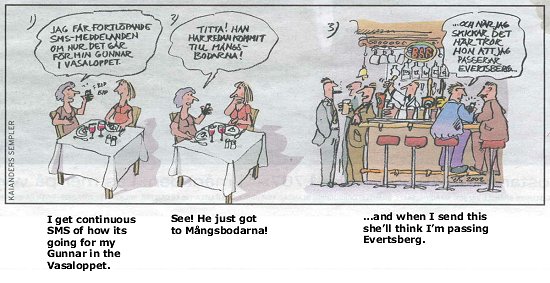
Related links
|



